AI Fraud Detection: How Banks Are Fighting Financial Crime in 2025

Oussama Bettaieb
Marketing Director

Share to AI
Ask AI to summarize and analyze this article. Click any AI platform below to open with a pre-filled prompt.
Artificial intelligence is evolving at an astonishing rate, but the possibilities for financial crime are expanding as AI becomes more powerful. Fraudsters now use AI to commit generative AI fraud, identity theft, and coordinate attacks on an unprecedented scale. This makes AI fraud detection more important than ever.
Aloa specializes in building custom AI solutions that drive real business outcomes, including fraud detection systems and automated risk management tools. Our skilled in-house team develops tailored AI applications that integrate flawlessly with existing systems. Whatever your needs, we can craft an AI fraud detection system that can identify threats in milliseconds, with minimal false positives.
With our extensive fintech expertise, we’ve written this blog to show you the ins and outs of AI-powered fraud prevention tools. We’ll break down:
- Exactly how AI fraud tech works
- What leading banks are achieving with them
- How your business can implement similar protections, without building everything from scratch
Whether you're protecting payment systems, customer accounts, or digital platforms, understanding AI fraud detection has become essential for any technology-driven business in 2025.
What is AI Fraud Detection in Banking?
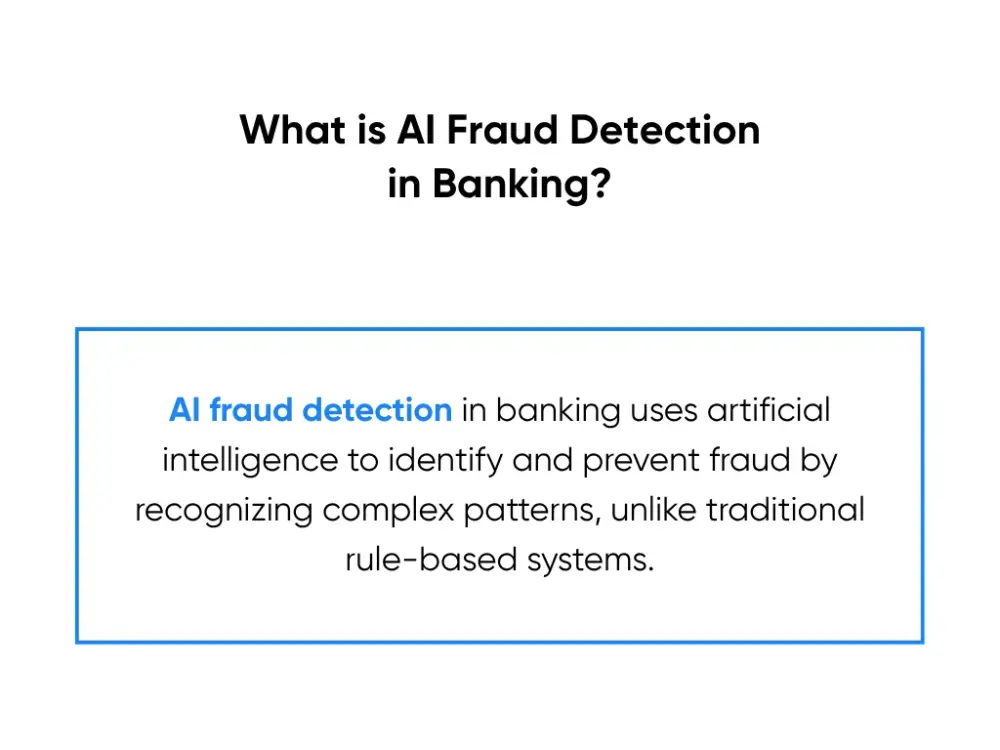
AI fraud detection in banking is the use of artificial intelligence to identify, prevent, and mitigate fraudulent activities in financial transactions and accounts. Unlike traditional rule-based systems that follow rigid "if-then" logic, AI fraud detection systems use machine learning to recognize complex patterns that indicate potential fraud.
These systems analyze hundreds of variables simultaneously:
- Transaction amounts
- Locations
- Timing
- Device fingerprints
- Behavioral patterns
- Network relationships
Each transaction’s risk level is scored according to these data points in real time.
The critical challenge lies in balancing precision with customer experience. AI systems must be sensitive enough to catch sophisticated fraud attempts while avoiding false positives that block legitimate transactions. Too aggressive, and customers face declined purchases and account freezes. Too lenient, and fraudulent transactions slip through undetected.
How AI Technologies Improve Fraud Detection
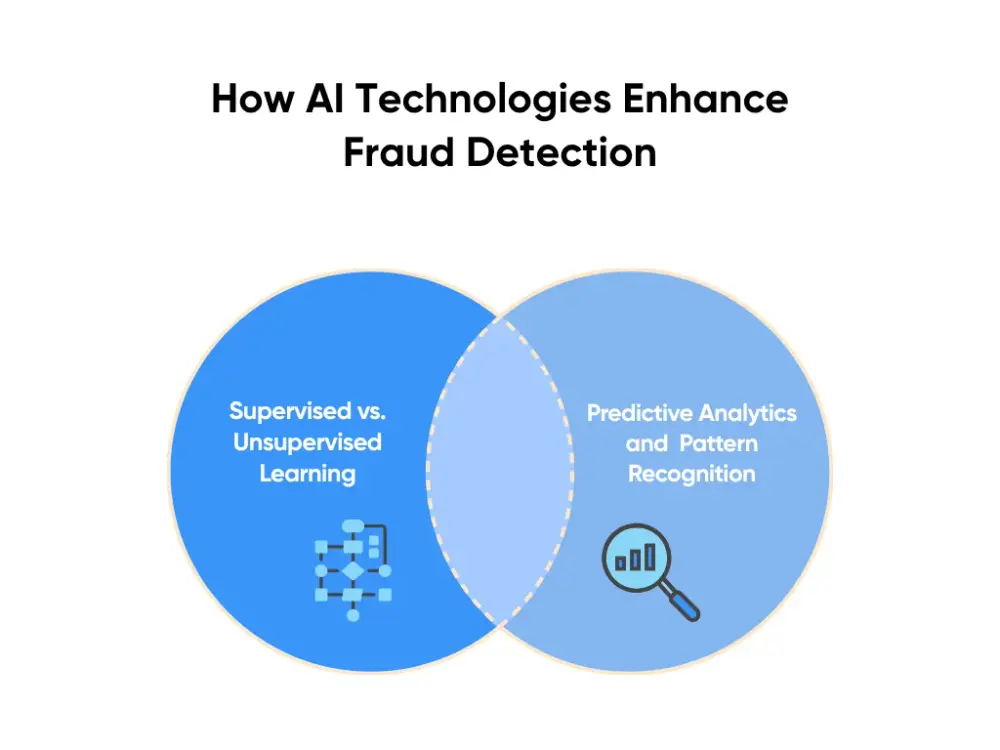
The core advantage of AI fraud detection in banking, and indeed fintech as a whole, lies in its ability to adapt. Technological advancements in natural language processing and deep fake technology are allowing for all-new ways to commit payment fraud, check fraud, and other significant threats. But even as fraudsters change tactics, machine learning models can automatically adjust by identifying new patterns in the data.
The shift from rule-based to AI-powered fraud detection introduces various advantages, from real-time processing capabilities to adaptive learning that evolves with emerging threats.
Supervised vs. Unsupervised Learning
Supervised and unsupervised learning are two techniques in machine learning that serve different purposes in modern AI banking fraud detection.
Supervised learning relies on historical labeled data to identify known fraud patterns.
Unsupervised learning enables anomaly detection without prior examples, essentially going in blind to identify unusual patterns and behaviors that deviate from the norm.
Both approaches are essential for comprehensive fraud prevention.
Supervised Learning
Excels when banks have labeled historical data showing which transactions were fraudulent and which were legitimate.
Common supervised techniques include:
- Decision trees: Create branching logic based on transaction features
- Random forests: Combine multiple decision trees for improved fraud detection accuracy
- Neural networks: Imitate human brain structures to identify complex non-linear patterns.
Banks typically use supervised learning for credit card fraud detection, leveraging years of labeled transactional data.
Unsupervised learning
Because they rely on historical patterns, supervised models can only detect fraud types they've seen before in training data. Unsupervised learning fills this critical gap by detecting anomalies without requiring labeled examples.
These algorithms identify transactions that deviate significantly from normal patterns, flagging potential new fraud types:
- Clustering algorithms: Group similar transactions together, highlighting outliers for investigation.
- Autoencoders: Learn to reconstruct normal transaction patterns. For example, fraudulent transactions produce higher reconstruction errors, signaling anomalies.
Banks deploy unsupervised learning for detecting emerging fraud schemes, money laundering patterns, and insider threats where labeled examples don't exist.
Predictive Analytics and Pattern Recognition
Predictive analytics enables proactive fraud prevention by forecasting fraud probability before transactions complete. These sophisticated probability models analyze historical patterns alongside real-time behavioral data, generating precise risk scores in milliseconds. This enables institutions to detect suspicious activity instantly and intercept fraud before it occurs.
Pattern recognition, on the other hand, identifies recurring sequences and relationships within transaction data that indicate fraudulent behavior. It examines factors like transaction timing, amounts, locations, number of times in a day, and merchant categories to detect suspicious patterns that human analysts might miss.
Real-World Implementations and Case Studies

Leaders in the financial services industry demonstrate that AI fraud detection delivers measurable results at scale:
- American Express: Their GPU-accelerated neural networks process billions of transactions in under 2 milliseconds each, using LSTM models for sophisticated pattern detection. This system improved detection accuracy by 6% in key segments, preventing $2 billion in fraud annually.
- PayPal: The company built a machine learning platform that enables precise distinction between unusual legitimate purchases and actual fraud. This approach improved fraud detection by 10% while reducing infrastructure costs by 8x.
- Feedzai: Their RiskOps platform serves 900 million consumers globally, processing $1.5 trillion in transactions annually with combined ML and human expertise. Banking clients achieve a 27% improvement in fraud detection, with institutions like Techcombank reducing detection time from hours to seconds.
This democratization of AI technology means world-class fraud protection no longer requires Fortune 500 resources. Any institution can access enterprise-grade capabilities through modern platforms.
Challenges in AI Fraud Detection
Training data quality
Training data quality is the foundational challenge in AI fraud detection. Machine learning models require vast amounts of accurate, labeled data to function effectively. Poor data quality leads to biased models that either miss fraud or generate excessive false positives.
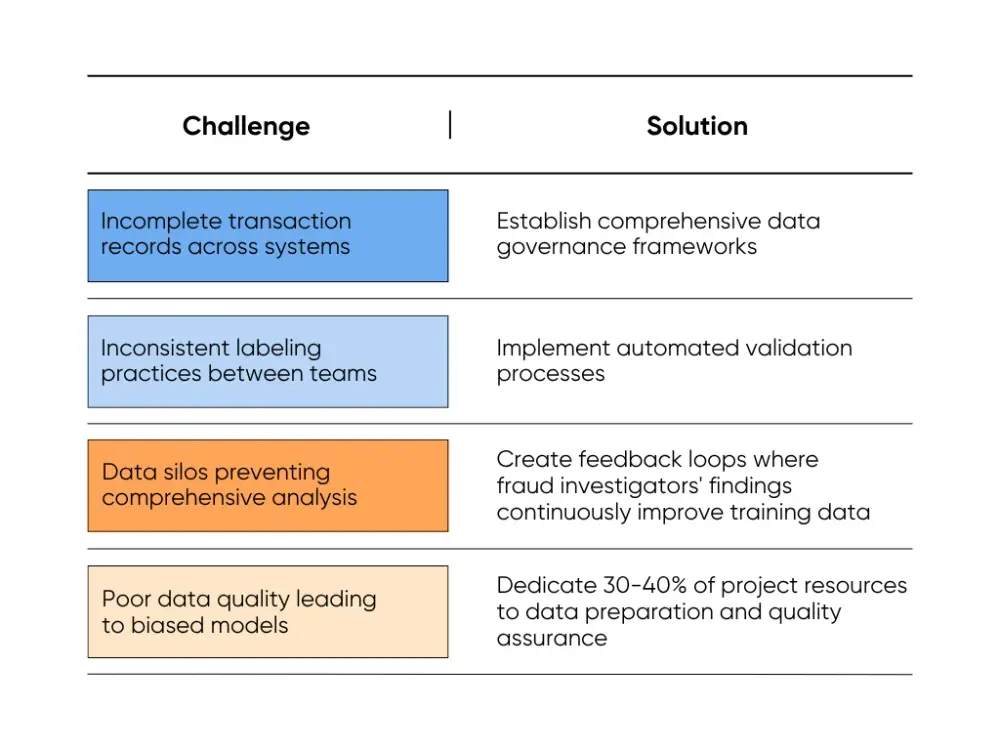
System integration
System integration complexity cannot be underestimated when implementing AI fraud detection in banking. Legacy banking infrastructure often resists modern AI platforms, with mainframe systems, batch processing architectures, and rigid security protocols creating technical barriers. Banks report integration costs often exceed AI platform costs by 2-3x.
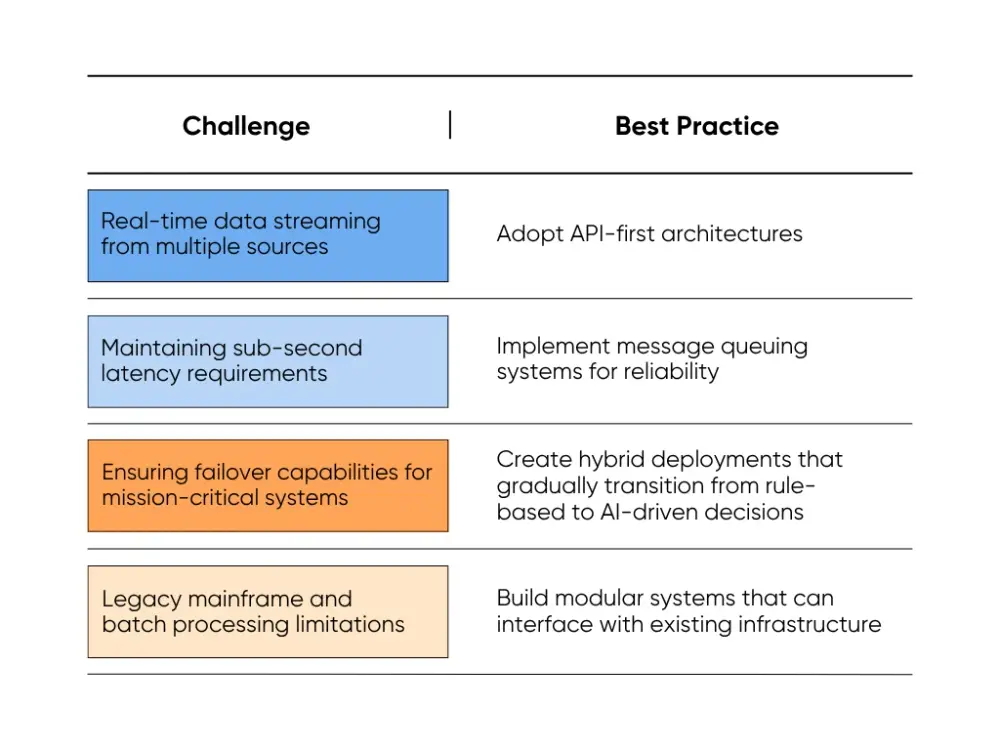
Regulatory concerns
As AI breaks new ground, regulations expand to cover the new capabilities being introduced. Banks must balance AI sophistication with regulatory compliance, often limiting model complexity to maintain explainability.
- Extensive documentation, regular audits, and explainable decision-making: The EU AI Act classifies fraud detection as high-risk AI requiring these measures. Banks should implement techniques like SHAP (SHapley Additive exPlanations) for model interpretability and establish regular audit schedules.
- Transparent data processing with customer consent: GDPR mandates this for all personal data usage. Organizations must create clear consent mechanisms and maintain comprehensive audit trails for every AI decision.
- Secure handling of payment data throughout AI systems: PCI DSS requires this for all payment card information. Financial institutions should build compliance into their foundation architecture with end-to-end encryption and data access controls.
Future Trends in AI-Driven Fraud Prevention
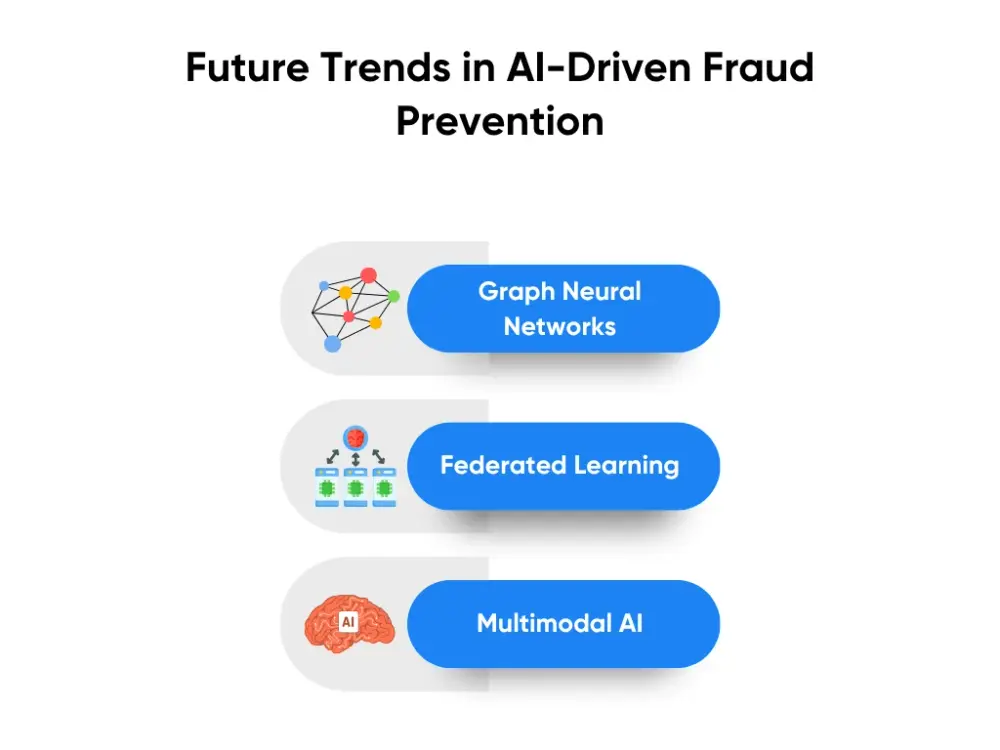
Graph neural networks (GNNs)
Graph neural networks represent the next frontier in fraud detection, analyzing relationship networks to expose sophisticated fraud rings. Traditional methods examine transactions in isolation, missing coordinated attacks across multiple accounts.
GNNs map the entire financial ecosystem as an interconnected graph: accounts become nodes, transactions become edges, and fraud patterns emerge from network analysis. This network-based approach reveals:
- Hidden connections between seemingly unrelated accounts
- Coordinated behavior patterns across fraud rings
- The path of money flow through multiple intermediary accounts
Early adopters report 15-30% improvement in fraud detection capabilities. Financial institutions can now access GNN capabilities through platforms like Amazon SageMaker and NVIDIA Rapids, reducing implementation complexity from years to months.
Federated learning
Federated learning solves the critical challenge of data privacy while improving detection accuracy through collaborative intelligence. This technology enables multiple banks to jointly train fraud detection models without sharing sensitive customer data; each institution's data remains local, while the collective learning benefits all participants.
Key benefits include:
- 10% higher accuracy compared to isolated systems
- Particularly valuable for smaller banks lacking sufficient fraud examples
- Complete data sovereignty while accessing collective intelligence
Industry consortiums are forming to leverage federated learning, creating opportunities for community banks to access the collective intelligence of larger networks while maintaining complete data sovereignty.
Multimodal AI
Multimodal AI combines multiple data types—transaction records, voice patterns, behavioral biometrics, and document images—for comprehensive fraud detection. This technology addresses sophisticated attacks like deepfake voice authorization and AI-generated fake documents.
Implementation results:
- 20-40% improvement in detecting complex fraud schemes
- Especially effective for account opening fraud that combines fake documents, synthetic identities, and social engineering
Multimodal AI is expected to become standard within 2-3 years as costs decrease and cloud platforms begin to offer them as services.
Key Takeaways
In 2025, AI fraud detection has become advanced enough to become essential banking infrastructure. 90% of financial institutions now use AI to combat increasingly sophisticated threats.
For growing companies, the path forward is clear: cloud-based platforms make enterprise-grade fraud detection accessible without massive upfront investments, typically delivering 300-2100% ROI within the first year. Start by assessing your monthly fraud losses and operational costs to establish a baseline, then evaluate solutions based on your transaction volume, integration requirements, and growth projections.
Don’t let fraudsters steal your profits. Stop them before they strike, with the power of AI. Aloa's AI fintech solutions are custom-built to your business needs, turning complex fraud patterns into actionable intelligence that protects every transaction. From custom algorithm development to financial system integration, Aloa delivers scalable fintech AI software that strengthens security while refining operations.
FAQs
How does AI reduce false positives in fraud detection?
By analyzing hundreds of behavioral patterns and contextual factors that rule-based systems miss. Machine learning models learn each customer's normal patterns to distinguish unusual credit card transactions and rapid fund transfers from legitimate activities. This nuanced analysis reduces unnecessary investigations by 60-80% compared to traditional systems.
What are the advantages of AI over traditional fraud detection?
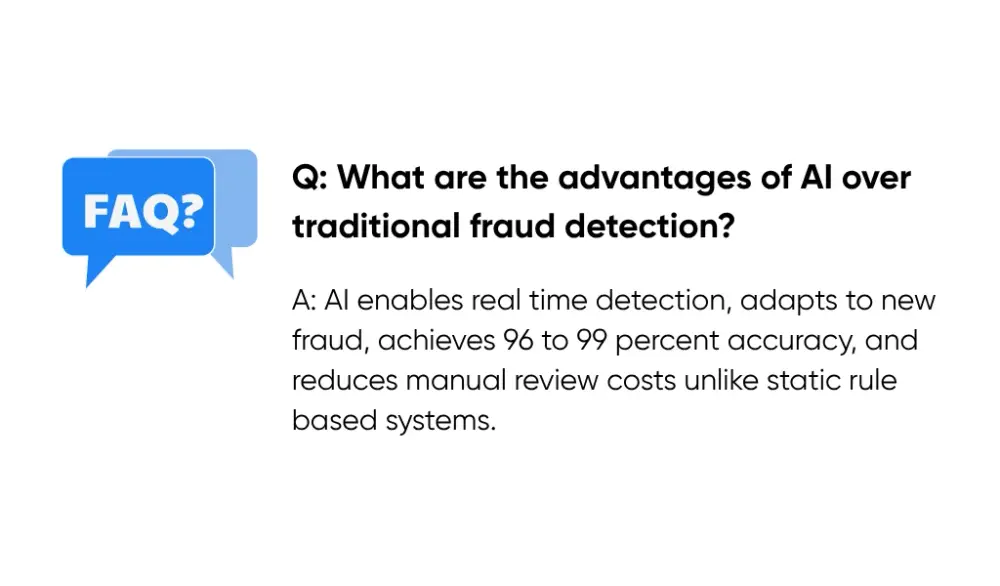
AI offers real-time processing (milliseconds vs. hours), adaptive learning that catches new fraud types, 96-99% accuracy rates, and dramatic reductions in manual review costs. Unlike static rule-based systems, AI continuously improves its detection capabilities without manual updates. With improved image recognition tech, AI-enabled tools are also much better at identity verification.
Is AI fraud detection expensive to implement?
Cloud-based AI fraud detection has become surprisingly affordable, with SaaS solutions starting at $500-5,000 monthly for SMBs. Most companies see positive ROI within 3-7 months through reduced fraud losses and improved operational efficiency. Pay-per-transaction models eliminate large upfront investments.
Can small banks use AI for fraud prevention?
Yes, modern cloud platforms have democratized AI fraud detection. Small banks can access the same sophisticated models used by major institutions through vendors like Feedzai, Stripe, and AWS. These solutions require minimal IT resources and scale with transaction volume.